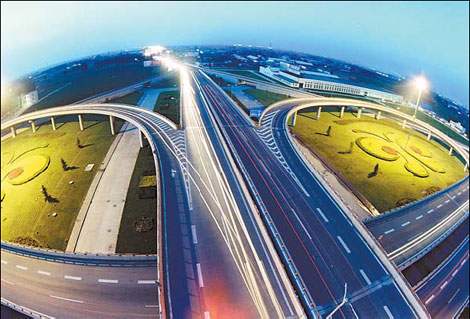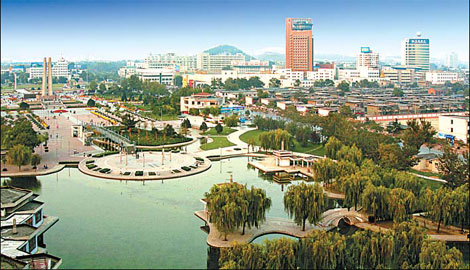In the north of Hebei Province, the city of Tangshan has a long, at times heartbreaking history, but today it is a modern metro area emphasizing sustainable development.

Nanhu eco-city
With the Bohai Sea to the south, the Yanshan Mountains to the north, Tianjin on the east, and Qinghuangdao on the west, the city is at the middle of the Bohai Bay area.
It has a coastline of 198 km and the ports of Caofeidian and Jingtang. It governs two county-level cities, six counties, six districts and six development zones within its 13,472 sq km, with 3,874 sq km of urban development. The city's total population is 7.25 million with 3.03 million in the urban areas.
Tangshan's history includes brilliant culture. Its ancient people worked hard on the abundant land beginning 40,000 years ago.

Many cultures are interwoven in the area, including those distinctly agricultural, those from the central plain, culture unique to the grasslands or embracing the sea.
Folk arts like Laoting drum storytelling, Pingju opera and shadow plays are popular around Tangshan.
Many noted historical figures were born in the city, including Li Dazhao, one of the early founders of the Communist Party of China, and Cao Xueqin (1715-1763), author of one of China's greatest novels, A Dream of Red Mansions, written in Qing Dynasty (1644-1911).
Tangshan's history has led to some prized humanistic characteristics - gratefulness, philanthropy, openness and transcendence.
It is also a heroic place. In 1976, a devastating earthquake took the lives of an estimated 270,000 people and virtually destroyed a century of industrial progress in the city.
In the 30 years following the quake, the people of Tangshan built a modern city from the ruins through 10 years of reconstruction, 10 years revitalization and another 10 years of new development.
In 2006, Chinese President Hu Jintao made an inspection tour of the city on the 30th anniversary of the great earthquake. Hu put forward his strategic conception of building the city into a demonstration region for scientific development.
Following President Hu's instructions, Tangshan's people are accelerating the process of transformation away from resource-dependent city to build Tangshan into a new ecological city.
Ecological industry

Tangshan is one of the cradles of China's modern industry. The city created many firsts in China, including the first mechanized mining of coal, the first railroad of standard track gauge, the first locomotive, the first bucket of machine-made cement, and the first sanitary porcelain.
Over years of development, Tangshan became a center of heavy chemical industry and energy resources.
The city has now moved to promote new industries and a recycled economy.
The Caofeidian industrial area is one of the first demonstration projects for a recycled economy that promotes reuse along the industrial chain, including recycling waste and water.
All its seven major industries are required to meet environmental standards. For production of steel, chemicals, agricultural products, modern services and hi-tech, environmental protection is a must of modern sustainable approaches in the zone.
In addition to the Caofeidian new district, Tangshan is forming a Laoting new district, Fengnan sea industrial area and the Luhan development area to build an economic belt along the coastline.
Interaction between new areas and old industrial sites will lead to more ecological development, the city government says.

Tangshan has a well-developed expressway network.
Ecological agriculture
Tangshan is famous as the granary of Hebei Province, with beautiful forests to the north and the sea in the south.
The local government is emphasizing standardization over thousands of hectares of agricultural land to prevent use of harmful substances.
Numerous products and enterprises are now entitled to use the term "green" food.
Based on the development of ecological agriculture, Tangshan is coordinating the city and country areas to achieve equal development, including lowering barriers to migrant workers and providing them with healthy and educational benefits.

A beautiful view of the city
Ecological city
Tangshan had been awarded an international honor by the United Nations and the Dubai International Award for best practices to improve the living environment for its reconstruction after the earthquake and the ecological efforts in its coal-producing zone. It also received an award as the National Garden City of China.
The local government plans to integrate the north mountain city zone and the south coastal zone, changing of the inland city to a coastal area.
Tangshan is also combining ecological designs, clean production and new approaches to save resources.
The local government has introduced German advanced technology to transform the energy supply system built after the earthquake. More than 130 industry enterprises will be moved and transformed in three years.

Modern Tangshan

(China Daily July 31, 2008)